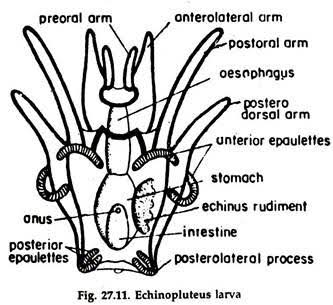W.B.C.S. Examination Notes On – Larval Forms Of Echinodermata – Zoology.
W.B.C.S. Exam is conducted by PSC, WB in three stages- Prelims, Mains and Interview. The marks you fetch in W.B.C.S. Mains Exam decide your ranking in the final list. The WBCS Mains exam has 8 papers, including twp optional papers. Zoology is an optional subject for Civil Services Mains examination. Zoology requires a huge amount of hard work. This optional paper is also quite lengthy. Aspirants should be thorough with the syllabus. Knowing the syllabus will help you to understand what to study what not to study.Continue Reading W.B.C.S. Examination Notes On – Larval Forms Of Echinodermata – Zoology.
Pluteus Larva:
1. Five to six pairs of arms supported by calcareous rods and with pigmented tips.
2. Presence of four ciliated bands forming epaulettes at the base of the postoral and posterodorsal arms.
3. Arms are preoral, anterolateral, anterodorsal, postoral, posterodorsal and posterolateral.
Two types of pluteus larvae, ophiopluteus and echinopluteus, are present:
Ophiopluteus larva:
1. Free-swimming.
2. Arms are four pairs, slender and supported by calcareous skeleton.
3. Posterolateral arms are longest and directed forward, giving the larva V-shaped appearance.
4. Ciliated bands are present on the edges of arms.Click here to find the Syllabus for Zoology in WBCS Exam.
5. The alimentary canal is divisible into mouth, oesophagus, stomach and intestine opening through the anus .
Ophiopluteus is the larva of Ophiuroidea. In viviparous forms, Amphiura vivipara, the pluteus stage is omitted. In Ophionotus hexactis, the development takes place in ovary and pluteus larva (Fig. 27.10B) is devoid of arms and anus.
Echinopluteus larva:
1. Free-swimming.
2. Arms five or six pairs, pigmented and supported by calcareous skeleton.
3. The posterolateral arms are very short and directed outward or backward.
4. The skeletal rods simple or thorny or fenestrated or branched.
5. The zones of the alimentary canal are mouth, oesophagus, stomach and intestine opening through the anus.
Auricularia and Doliolaria Larvae:
These larval forms occur in Holothuroidea.
Auricularia larva:
1. A free-swimming form.
2. Body barrel-shaped and bilaterally symmetrical.
3. The preoral lobe is well formed.
4. A single winding ciliated band, which may be produced into lobes (Fig. 27.12 A).
5. Gut with mouth, sacciform stomach, hydrocoel and right and left stomocoels and anus.
6. The hydrocoel becomes lobulated forming primary tentacles and communicates with the hydropore by a canal.
7. Calcareous rods replaced by spheroid or star-shaped or wheel-like bodies.
The auricularia larva is transformed into a Doliolaria larva similar to that of Crinoidea.
Doliolaria larva:
1. A free-swimming form.
2. Body barrel-shaped and bilaterally symmetrical.
3. Preoral lobe well-developed.
4. Wavy, continuous band break into 3-5 flagellated, transverse rings (Fig. 27.12B).
5. The gut with distinct zones.
Phylogenetic relationship:
Due to presence of enterocoelic coelom and some other minor resemblances, attempts have been made to establish a relationship between auricularia and tornaria larva of Hemichordata. This theory is now in dispute. Garstang (1894) propounded that the tadpole larva of Ascidia probably evolved from auricularia larva.
1. A free-swimming form.
2. Body elongate oval, a little narrower posteriorly (Fig. 27.13).
3. Presence of 4-5 transverse ciliated bands around the body.
4. An apical sensory plate with a bunch of cilia at the anterior end.
5. An adhesive pit over the first ciliary band in the mid-ventral line close to the apical plate.
6. Gut with distinct zones and the stomodaeum between the second and third ciliated bands.
7. The skeletal structures present.
The larva attaches itself to some support and the internal organs rotate at 90° angle from ventral to posterior position. A stalk develops and the larva turns to a cystidian larva, which metamorphoses to a young individual.
Homology and phylogeny of echinoderm larvae:
Except for the crinoids, a sedentary group, the larvae of Asteroidea, Holothuroidea, Echinoidea and Ophiuroidea exhibit some fundamental resemblances.
1. Preoral and postoral loops.
2. Ciliated bands V-shaped.
3. Presence of gut with its divisions and openings.
4. Coelom enterocoelic.
These and other common features indicate they had a common ancestor.
Please subscribe here to get all future updates on this post/page/category/website


 Toll Free 1800 572 9282
Toll Free 1800 572 9282  mailus@wbcsmadeeasy.in
mailus@wbcsmadeeasy.in



















































































































